Thursday, May 27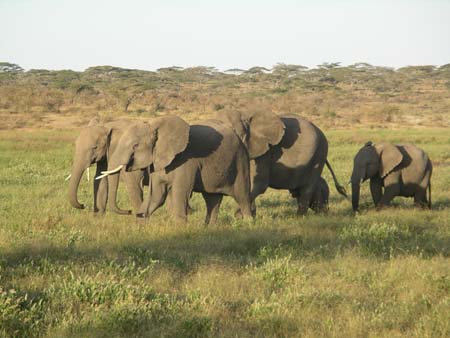
Steve: Leaving the scene of a possible "kill" was not easy last night, and Nassibu suggested that we make an early-morning visit back to Lake Masek to see if there was any evidence of what happened to the solitary, unsuspecting lion. Setting out at 6:30AM we were treated to another sunrise over a forest of large acacia trees, and we also saw a variety of wildlife (Kirk's dik-diks, warthogs, impalas, jackals, hartebeests) on our way. Upon arriving at the lake, we searched the area but found no remains of the zebra and no sign of the lions. Nassibu conjectured that the zebra probably escaped and the lions had moved on. Most hunts are not successful, and out of the three main predators (leopards, cheetahs and lions) the lions are the least effective. Lions move frequently from one spot to another, especially if they are unsuccessful in hunting, and so this pride had probably spent the night searching for prey before settling down in their next area and a full day's rest.
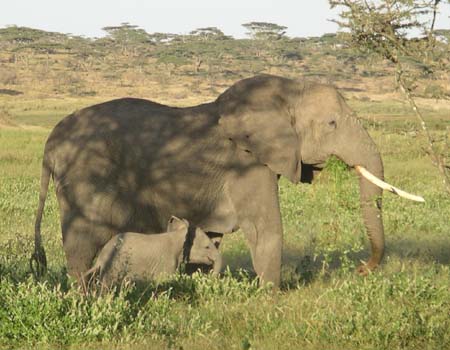 We
continued exploring Lake Masek, driving on a small road that hugs the shore.
We watched as several large hippos wallowed in the shallows, somewhat surprised
that they were already cooling themselves this early in the morning. The hippos
feed on land at night, and then spend most of their days in water and mud.
After several minutes, Nassibu started looking intently toward the far shore,
a sign that we already know means that he's probably spotted the signs of
something special. He told us that there were some very fresh elephant droppings
and tracks in the road, and that he expected the elephants to be very near.
Once again, Nassibu was right on. As we rounded a corner, we saw a beautiful
family of elephants grazing in a field of long green grass. They were headed
directly toward an area where we could park the Land Rover without disturbing
them, and so this was a perfect opportunity for us to view them at close range.
We
continued exploring Lake Masek, driving on a small road that hugs the shore.
We watched as several large hippos wallowed in the shallows, somewhat surprised
that they were already cooling themselves this early in the morning. The hippos
feed on land at night, and then spend most of their days in water and mud.
After several minutes, Nassibu started looking intently toward the far shore,
a sign that we already know means that he's probably spotted the signs of
something special. He told us that there were some very fresh elephant droppings
and tracks in the road, and that he expected the elephants to be very near.
Once again, Nassibu was right on. As we rounded a corner, we saw a beautiful
family of elephants grazing in a field of long green grass. They were headed
directly toward an area where we could park the Land Rover without disturbing
them, and so this was a perfect opportunity for us to view them at close range.
We watched these amazing animals as they slowly walked through the field,
pulling up huge bunches of grass. Elephants eat for 16 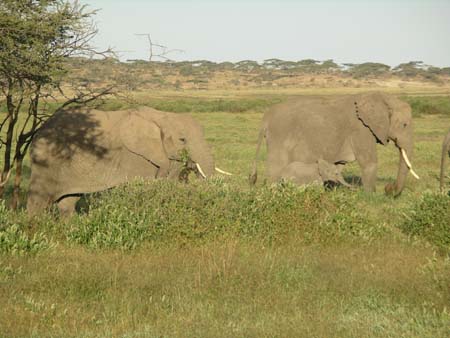 hours
every day, consuming 300 pounds of food and drinking 20 gallons of water.
This was a family of full-grown females (we never realized that female elephants
have tusks) and a very small baby that was less than a year old. The baby
was very cute, always staying right by its mother's side.
hours
every day, consuming 300 pounds of food and drinking 20 gallons of water.
This was a family of full-grown females (we never realized that female elephants
have tusks) and a very small baby that was less than a year old. The baby
was very cute, always staying right by its mother's side.
Seeing the elephants so close was really wonderful. It was a beautifully
bright and crisp morning, and we loved sitting and watching these huge animals
grazing peacefully in such a splendid setting. Eac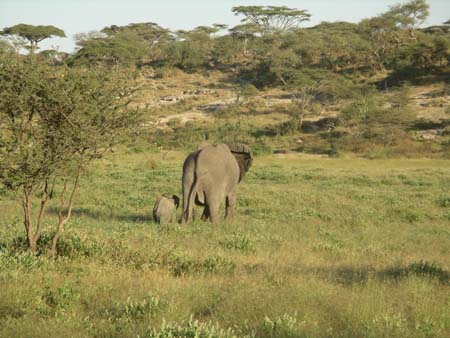 h
day our experiences seem to get better and better - we think back of how excited
we were on our first day to have seen a single elephant, even though we were
fairly far away. Then, near the Moru Kopjes we saw the larger herd, but at
quite a distance. And now here we were, not more than 50 feet from a family
with a baby - fantastic!
h
day our experiences seem to get better and better - we think back of how excited
we were on our first day to have seen a single elephant, even though we were
fairly far away. Then, near the Moru Kopjes we saw the larger herd, but at
quite a distance. And now here we were, not more than 50 feet from a family
with a baby - fantastic!
After breakfast back at the Ndutu Lodge, we set out toward the east and the Ngorongoro area. Our drive took us again through wide open plains and we stopped several times in amazement at the sheer number of animals that were visible. We would look around and see a variety of gazelles, hyenas, jackals, ostrich, hartebeest, and elands all grazing, watching for predators or simply resting. At one point we stopped to watch a hyena eating a Thomson gazelle (a recent kill), with its den-mates working hard to fend off hyenas from a rival pack. Jackals and vultures were also nearby, and we realized that making the kill is only part of the challenge for animals here - once they have brought down their prey, they must defend it against those looking to share in the meal. In these wide-open plains, there is literally no place to hide.
We had to look twice when we drove by two young boys standing on the side
of the road. These were the first Maasai that 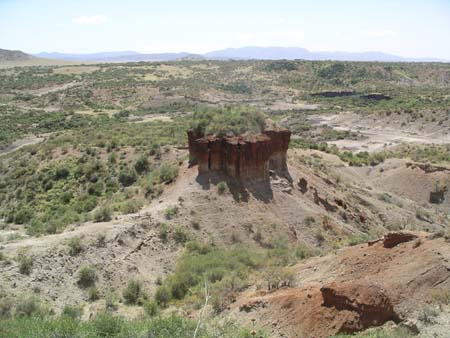 we
have seen since we left Arusha, and it actually felt strange to see people
walking outside (since no one walks outside in the Serengeti). The Maasai
have unique abilities to stay away from dangerous animals and live in harmony
with the native wildlife. Under agreements signed with the Tanzanian government,
the Maasai are allowed to live and raise their cattle in the Ngorongoro region
but not in the Serengeti. We have several days planned later during our time
in Tanzania where we will have the opportunity to meet some Maasai people
and visit their villages.
we
have seen since we left Arusha, and it actually felt strange to see people
walking outside (since no one walks outside in the Serengeti). The Maasai
have unique abilities to stay away from dangerous animals and live in harmony
with the native wildlife. Under agreements signed with the Tanzanian government,
the Maasai are allowed to live and raise their cattle in the Ngorongoro region
but not in the Serengeti. We have several days planned later during our time
in Tanzania where we will have the opportunity to meet some Maasai people
and visit their villages.
Before heading to the crater, we stopped at the Oldupai Gorge, the site of many significant archaeological discoveries. This is where Mary Leakey did her research, and is also the place where fossilized hominid footprints dating back 3 ½ million years were found. These footprints provide the world's earliest record of hominids walking on two feet.
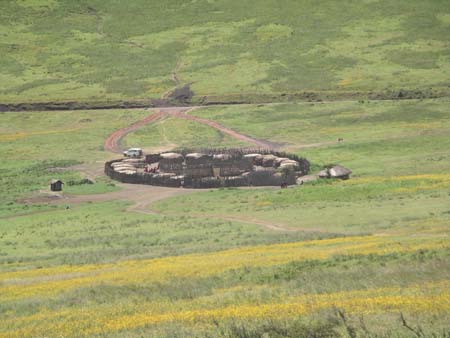 The
drive to Ngorongoro took us by several Maasai villages, all built of tree
branches, wood and straw. These are temporary homes since the Maasai are primarily
nomadic, moving to the places with the best food and water for their cattle.
The Maasai are purely herders, and do no farming, and the health of their
animals is very important. We saw many abandoned villages during our drive
today.
The
drive to Ngorongoro took us by several Maasai villages, all built of tree
branches, wood and straw. These are temporary homes since the Maasai are primarily
nomadic, moving to the places with the best food and water for their cattle.
The Maasai are purely herders, and do no farming, and the health of their
animals is very important. We saw many abandoned villages during our drive
today.
After a stop to fix a flat tire at the gas station on the western rim of
Ngorongoro, we began our descent into the crater. Ngorongoro crater is actually
a caldera, or collapsed volcano. It is a spectacular and unique setting for
a huge variety of wildlife, and is home to over 25,000 large animals. Most
of these animals make the crater their permanent home, although many leave
temporarily during the heavy rains. There is one primary path that the animals
use to enter and leave the crater. The crater floor sits 2,000 feet below
the rim and is roughly 10 miles in diameter. The view from the rim is incredible
with the entire crater fully visible from the top. 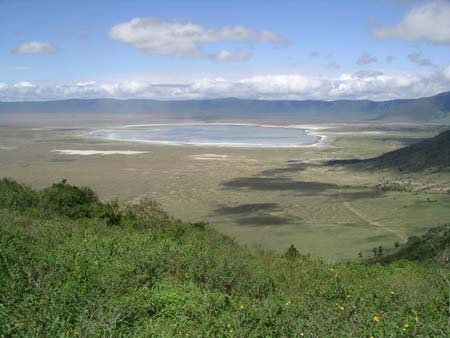
As we descended, the wildlife below started to become visible initially as black spots on the crater floor. Soon we were able to make out animals scattered throughout the crater, and became very excited about beginning our exploration.
Although we only had a few hours this afternoon inside the crater, we quickly
got an appreciation for how remarkable a setting this is. The entire rim is
visible from the floor, with forested walls rising all around. The floor is
completely flat and is primarily grassland, with Lake Magadi sitting in the
western section. The wildlife is literally everywhere, and in some respects
Ngorongoro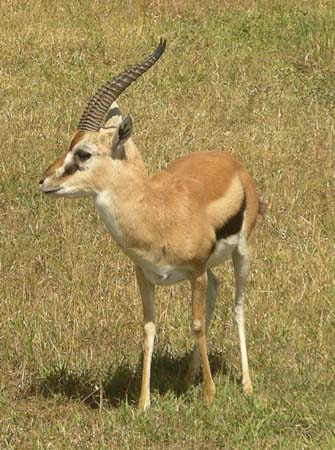 feels like a huge natural zoo. The plains are filled with wildebeests, gazelles,
zebras, hyenas, buffaloes, antelope, ostriches, and jackals. There are also
roughly 100 resident lions, several solitary elephant bulls, a family of cheetahs,
a few leopards and, very significantly, 16 of the endangered black rhinos.
Lake Magadi is home to a large colony of greater and lesser flamingoes that
reside here until nesting season.
feels like a huge natural zoo. The plains are filled with wildebeests, gazelles,
zebras, hyenas, buffaloes, antelope, ostriches, and jackals. There are also
roughly 100 resident lions, several solitary elephant bulls, a family of cheetahs,
a few leopards and, very significantly, 16 of the endangered black rhinos.
Lake Magadi is home to a large colony of greater and lesser flamingoes that
reside here until nesting season. 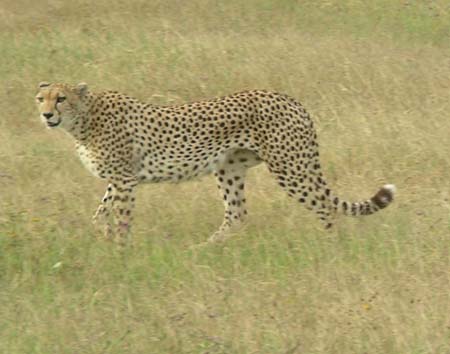
In a few short hours, we had been lucky enough to see all the animals listed
above. Our most exciting sighting was a family of four cheetahs. We first
saw these large cats at a distance, and Nassibu suggested that we return later
when they were likely to be crossing the road and heading toward the lake.
Unbelievably, Nassibu was exactly right again. After spending just over an
hour observing elephants and other animals, we returned to the area of the
cheetahs to find the mother and three juveniles walking directly toward us.
We watched quietly as they filed across the road directly in front 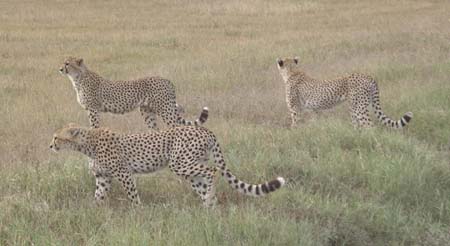 of
us and walked slowly toward the lake. The cheetahs are strikingly beautiful,
with thin, graceful bodies a
of
us and walked slowly toward the lake. The cheetahs are strikingly beautiful,
with thin, graceful bodies a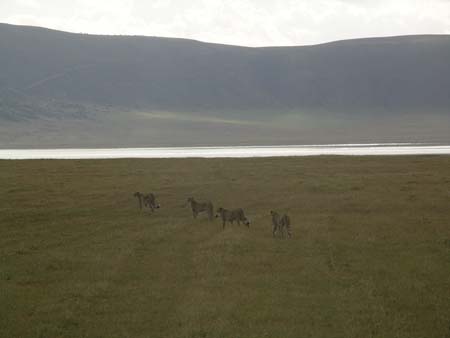 nd
long tails. We had been hoping to see cheetahs (this was the last large animal
that we hadn't yet seen), but never imagined that we would be able to see
them at such close range. It was great!
nd
long tails. We had been hoping to see cheetahs (this was the last large animal
that we hadn't yet seen), but never imagined that we would be able to see
them at such close range. It was great!
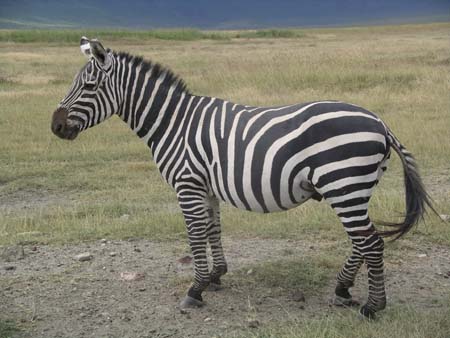
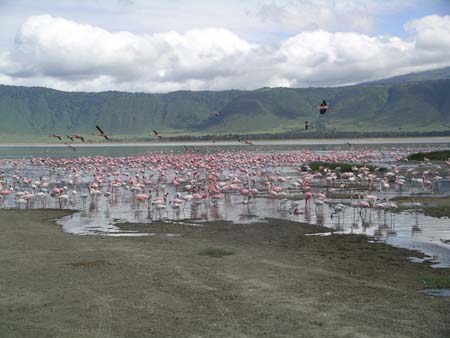
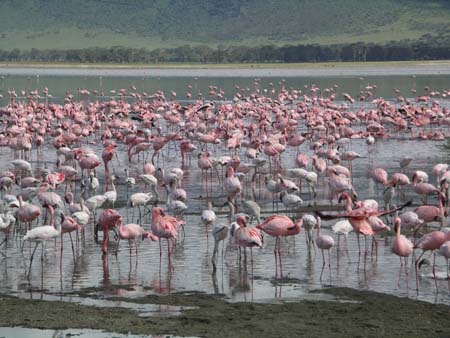
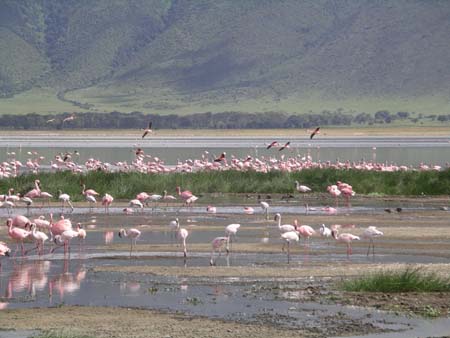
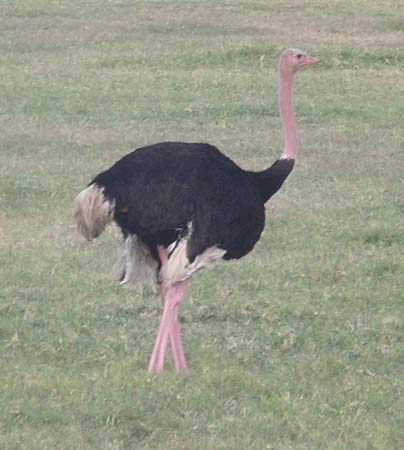
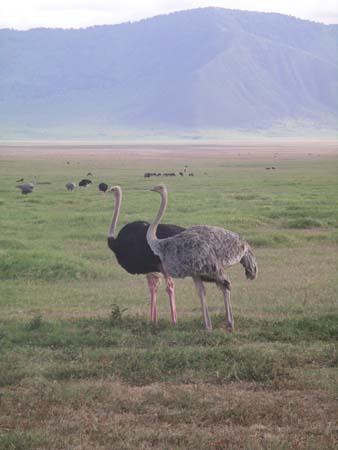
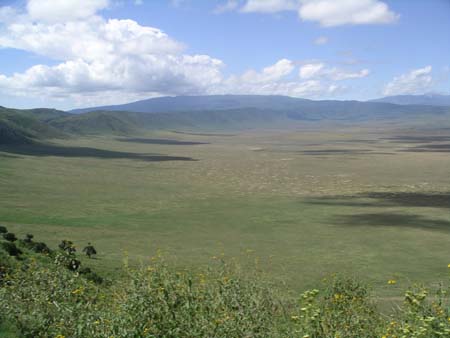
We also spotted three black rhinos at a distance. The rhinos stay in the
forests during the evening, but c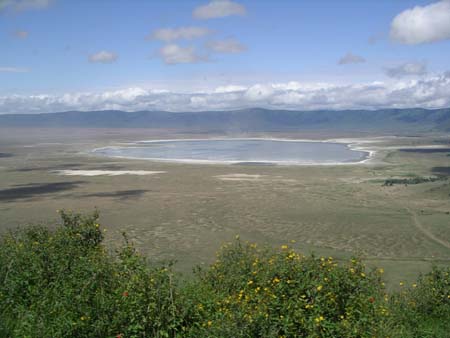 ome
out to graze during the afternoon. The rhinos have acute hearing and generally
do not come near the road - therefore, they are normally viewed at a distance.
We hoped that one would come closer, but for today settled on watching them
through our binoculars. Nassibu told us that many times, people come specifically
to see the black rhinos and end up disappointed when they aren't able to find
any. We feel very fortunate to have now seen the rhino both in the Serengeti
and inside Ngorongoro.
ome
out to graze during the afternoon. The rhinos have acute hearing and generally
do not come near the road - therefore, they are normally viewed at a distance.
We hoped that one would come closer, but for today settled on watching them
through our binoculars. Nassibu told us that many times, people come specifically
to see the black rhinos and end up disappointed when they aren't able to find
any. We feel very fortunate to have now seen the rhino both in the Serengeti
and inside Ngorongoro.
Finally, after a long and very successful day, we headed up the eastern rim toward the Sopa Lodge, our home for the next two nights. We were somewhat surprised at how large and comfortable the lodge is, with fantastic views looking down onto the crater. It also felt very unusual to see so many tourists in one place - so far we haven't seen many other visitors in Tanzania.
Tomorrow we have a full day planned to explore the floor of the Ngorongoro crater.
Katie's Kwick Kwacks: Zebras. We looked in wonder at the strange creatures.
They were like nothing we had ever seen before. Their bold black stripes stood
in stark contrast to the snow white of their bodies. Their faces were amazing
- there were so many complicated stripes streaming down their faces. They
were beautiful, yet very bizarre looking. 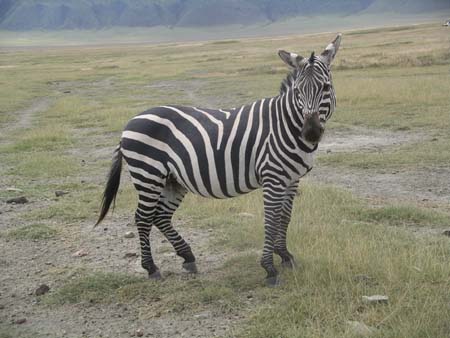 These
animals just didn't seem to fit in. We soon learned, however, that they indeed
have very important roles here in the Serengeti. The migration of the herds
is one of them.
These
animals just didn't seem to fit in. We soon learned, however, that they indeed
have very important roles here in the Serengeti. The migration of the herds
is one of them.
There are about 500 thousand zebras in the entire Serengeti. They are considered the wild horses of Africa. Although the overall form of the zebra's body looks similar to that of a common horse, they are visibly very different. Their black and white stripes are breathtaking and very conspicuous. From up close, these animals seem like easy prey for any lion that happens to be around. Although striking, their bold stripes are actually a form of camouflage when seen at a distance on the horizon. These stripes are also useful when a lion is hunting a large herd - all of the black stripes together causes great confusion to the predator and makes it harder for them to pick out individual zebras. Their main defense when being attacked is to kick the predator with their hind legs.
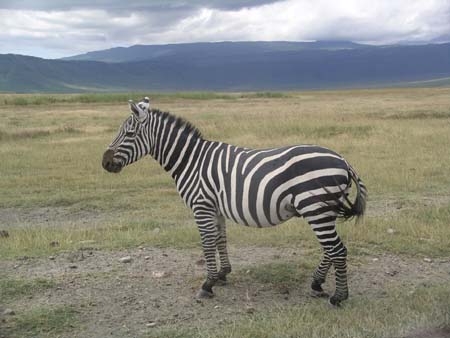 Like
most animals in the Serengeti, the zebras travel in harems - most are made
up of about 5 to 6 females and one leading stallion. The stallion usually
holds this group for about 15 years until he is defeated by a stronger male.
This fight involves lots of kicking and barking which can be heard from far
away. It is incredible to see these animals in their harems and note all of
their different stripe patterns. Can you believe that a zebra's stripes are
as individual as a human's fingerprints! .
Like
most animals in the Serengeti, the zebras travel in harems - most are made
up of about 5 to 6 females and one leading stallion. The stallion usually
holds this group for about 15 years until he is defeated by a stronger male.
This fight involves lots of kicking and barking which can be heard from far
away. It is incredible to see these animals in their harems and note all of
their different stripe patterns. Can you believe that a zebra's stripes are
as individual as a human's fingerprints! .
The zebras are perhaps most famous, however, for their participation in the
mass migration of the Serengeti. This yearly event involves the relocation
of the wildebeest and zebras in search of water and food. Although the population
of zebras in the migration is half of the number of wildebeest, they take
an obvious leading role in the operation of the journey. The group we saw
on our first day of viewing the migration was a great example of the leadership
roles the zebras take. The vast majority of the animals were wildebeest, but
in the very front was a family of zebras. We watched in fascination as the
zebras cautiously led the group of five thousand wildebeests and other zebras
toward the water hole. The first zebra was extremely alert and kept on walking
and stopping, with the entire herd following 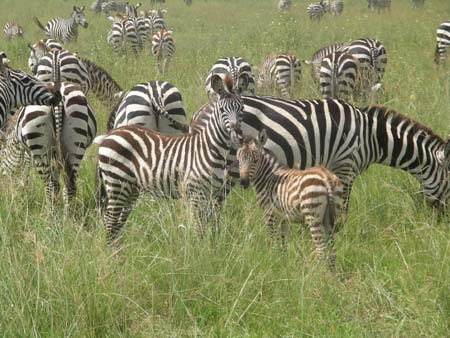 behind.
They were the only ones who weren't eating.
behind.
They were the only ones who weren't eating.
It was fascinating to see the patterns in their movements, and we got the impression that these animals were a lot smarter than the wildebeest. The zebras also did most of the organizing, and let the wildebeest ahead first as they supervised. Although the jumble of animals looked pretty chaotic at first sight, we soon realized that it all had an incredible sense of order to it. Every minute the groups would change directions, and we weren't sure how they would all end up in the same spot at the end. This is a great example of the complexity of the zebras' social behavior.
In conclusion, I think zebras are one of the most interesting, unique, and beautiful types of animals we have seen so far. I really enjoyed learning about this animal and observing its unusual behavior. Watching the zebras lead the migrating herds was an experience I will never forget. This behavior was a wonderful example of the harmony all of the animals here have together and with nature.
Animals seen today:
Elephant
Dik-Dik
Grants Gazelle
Thomson Gazelle
Impala
Golden Jackal
Hippo
Ostrich
Hyena
Zebra
Cape Eland
Black Backed Jackal
Hartebeest
Cheetah (mother and juveniles)
Rhinoceros (mother and baby)
New birds seen today:
Crowned Crane
Oltipi Gordpi
Gloss Avis
Less and Greater Flamingo
Horn Bill
